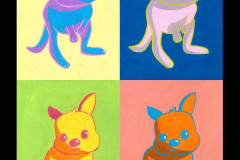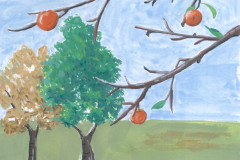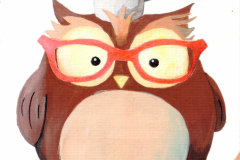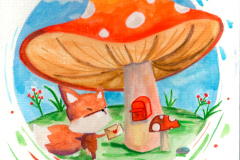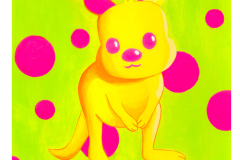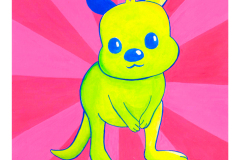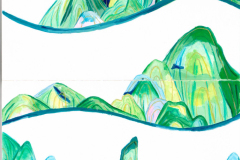Introduction
Gouache is a unique water-based paint that combines the qualities of watercolor and acrylics. It stands out due to its opacity and matte finish, making it a favorite for artists who want strong color coverage and vibrant results. This tutorial series is designed to help you understand gouache’s properties, techniques, and how it fits perfectly within mixed media art. Learning how to use gouache effectively opens new doors to creativity and allows you to experiment with layering, textures, and bold colors.
Mixed media art involves using various materials and techniques to create complex and dynamic artwork. Incorporating gouache into mixed media projects enhances your artistic options since gouache can be combined with dry and wet media, collage elements, and other textures. You will learn how to prepare surfaces, mix colors, manage drying times, and combine gouache with other materials for intriguing effects. This guide encourages you to explore the possibilities of gouache and mixed media to express your creativity fully.
Understanding Gouache Paint
Gouache paint combines pigment, binder agents, and white fillers to create a specialty paint used by artists worldwide. The pigments provide color, while the binder, commonly gum arabic or dextrin, holds these pigments together. White fillers, often chalk or calcium carbonate, add opacity and bulk, helping to produce a matte and solid finish.
The unique characteristics of gouache set it apart from other painting media such as watercolor or acrylic. Unlike watercolor, gouache offers full coverage with its opacity, letting you paint light on dark colors effectively. In comparison to acrylic, gouache has a softer matte finish and reactivates with water after drying. This makes it versatile for adjustments and layering.
Historically, gouache played a significant role in commercial art, especially for illustration and design. Its fast drying time and vibrant finish made it popular among illustrators, advertisers, and designers before digital tools took hold. As you incorporate gouache into your mixed media projects, understanding these traits helps you control your art more confidently.
Gouache Composition and Properties
Gouache paint consists mainly of natural pigments, which provide rich and vivid colors. Gum arabic or dextrin acts as the binder, ensuring the pigment particles stick firmly to your surface. Chalk or other white fillers increase the paint’s opacity, allowing for solid, flat color coverage.
The chalk filler also affects drying time, making gouache dry quickly but remaining workable when reactivated with water. This contributes to its matte finish and smooth texture, which artists often prefer for detailed work or layering. The blend of pigments, binder, and fillers creates a balance between opacity and flexibility that suits both fine art and illustration.
When you paint with gouache, expect it to feel thicker than watercolor and show less transparency. These components influence how you layer and blend the paint. Experimenting with different brands and consistencies can reveal which formulas suit your style best.
Differences Between Gouache and Other Paints
Gouache stands out for its opacity, unlike watercolor, which tends to be transparent and fragile. This feature allows you to paint layers that completely cover previous ones, making corrections easier and layering more forgiving in mixed media projects.
Compared to acrylics, gouache dries faster and can be reactivated with water after it dries, while acrylic becomes water-resistant once dry. Acrylics also have a glossy finish, whereas gouache offers a matte surface, which many artists find useful for flat color fields or illustrations.
The ease of use varies too: watercolors flow smoothly but require careful control, acrylics are thick and fast-drying, and gouache sits in between with moderate thickness and flexibility. Would you want to use gouache for detailed line work or softer blending? Its drying time and reactivation capability give you more room to shape your image compared to acrylic.
The History of Gouache
The origins of gouache trace back thousands of years. Ancient Egyptian artists used opaque paints similar to gouache on tomb walls and papyrus. These early pigments allowed for solid, vibrant colors that stood the test of time. Gouache’s qualities made it ideal for detailed, long-lasting art. Later, European monks used gouache-like paints in illuminated manuscripts. The brilliant colors and matte finish highlighted texts and decorations vividly.
Over centuries, artists adapted gouache for various techniques. Renaissance painters found it useful for sketches and studies. Its opacity helped reveal form and light quickly. As printing and commercial arts developed, gouache became a preferred medium for illustrations and design, prized for precision and boldness. Can you imagine how this paint shaped the way images were created before digital tools?
Early Uses of Gouache in Art
Gouache or similar opaque water-based paints played a big role in Persian miniature art. These tiny, detailed paintings used rich pigments layered to build vibrant scenes. Artists valued gouache for its quick drying time and the ability to correct mistakes. Manuscript illuminators added gold leaf, and gouache gave strong tonal contrasts that made text and images stand out.
In India, gouache techniques influenced traditional Mughal paintings, combining realism and decorative detail. You might wonder how these early artists managed such precise effects without modern brushes or supplies. Their skill with gouache helped shape storytelling through visual art for centuries.
Modern Adaptation of Gouache
Gouache found a new life with commercial artists in the 20th century. Its vibrant, flat colors suited advertising and poster design perfectly. Many illustrators used gouache to create bold book covers and magazine art, where clear, crisp images grabbed attention.
Animation studios turned to gouache for backgrounds and character designs. The paint’s quick drying and opacity allowed efficient production yet rich details. Today, many mixed media artists combine gouache with digital prints, ink, and collage. You can integrate gouache into your projects to add solid color layers or subtle highlights, just like pros do across creative fields.
Basic Techniques for Painting with Gouache
You will find gouache behaves differently from other paints due to its quick drying and strong opacity. Mastering basic techniques helps you control these features and use them for diverse effects. Layering is key. Apply thin washes first and let them dry completely before adding more layers. Each new layer can either enhance color depth or cover previous marks completely depending on the paint’s thickness.
Handling gouache requires you to work swiftly but patiently. Drying too fast means you must plan your strokes carefully and use smaller areas at a time. That opacity lets you paint solid shapes without multiple coats, but also challenges you to blend colors thoughtfully.
Try combining wet and dry applications to create contrast. Experiment with water amounts to vary opacity and texture. How will you balance the paint’s thickness to bring out different effects in your mixed media work? Practicing these techniques will build a solid foundation for your gouache projects.
Layering and Opacity Control
Start with thin layers to map the composition. Water down your gouache to create translucent washes that give subtle color buildup. Let each layer dry before adding another to avoid muddy colors or unwanted mixing.
Use opaque layers when you want to highlight or cover mistakes. Gouache’s hiding power lets you paint light over dark or vice versa, which is helpful for corrections or adjustments during your process.
Think strategically about coverage. Rather than applying all paint thickly at once, build your painting gradually to control depth and value. If you want a misty or glowing effect, use diluted layers. For sharp edges and solid shapes, apply the paint straight from the tube or with minimum water. How can you combine transparency and opacity to create visual interest?
Blending and Texture Creation
Blending gouache smoothly requires working while the paint is wet. Use a damp brush to gently merge colors on the paper. You can soften edges or create subtle gradients by adding small amounts of water and moving the brush lightly.
For textures, vary your brush strokes. Dry brushing with less water produces rough, broken marks. Short, stippled touches add dimension and energy. Scraping into wet paint or layering thicker strokes enhances tactile effects.
Are you ready to explore how texture can add mood or focus in your work? Mixing smooth blends with textured areas brings contrast and depth. Practice different blending speeds and brush pressures to find what suits your style. How will you use these methods to complement your mixed media layers?
Choosing the Right Tools and Surfaces
Your choice of brushes and surfaces shapes how gouache behaves and how your artwork turns out. Using the proper tools gives you control over the paint’s opacity, texture, and detail. Brushes with different shapes affect how you apply paint—some make broad strokes easy, while others are better for fine details.
Surface texture and material also alter how the paint dries and looks. Smooth papers allow for crisp edges, while rougher surfaces give texture to your strokes. Experimenting with various papers and boards can expand what you achieve with gouache, especially when mixing media.
Ask yourself: Do you want bold color blocks or delicate layers? Are you aiming for smooth blends or visible brush marks? Knowing this helps you pick the right combination. Choosing tools thoughtfully supports your creative vision and builds strong foundations for mixed media work.
Brush Types and Their Effects
Round brushes with stiff bristles work well for details and precise lines. Flat brushes cover larger areas quickly and produce clean edges. Filbert brushes, with rounded tips, create softer strokes and smooth transitions.
Natural hair brushes hold paint longer but wear out faster with gouache’s heavier pigment load. Synthetic brushes resist damage better and keep their shape through repeated use. You can use fan brushes to add texture by dabbing or sweeping paint lightly.
Try switching between shapes and materials to see which fit your style. For example, use a small round for fine highlights and a large flat for base layers. The tools you choose influence your workflow and how effectively you can express your ideas.
Surface Options for Gouache
Cold-pressed watercolor paper suits gouache well because it absorbs paint evenly and lets you layer without warping. Hot-pressed paper provides a smoother finish, ideal when you want clean lines and sharp details.
Cardboard or illustration board adds durability and reduces buckling, especially useful for heavier layers or mixed media projects. Some mixed media papers handle gouache along with inks, pastels, or collage materials without breaking down.
Have you tried painting on unconventional supports like wood panels or canvas boards? These add texture and weight, and you can prepare them with gesso to make gouache stick properly. Exploring different surfaces opens doors to new artistic effects and keeps your work fresh.
Color Mixing and Matching with Gouache
Mixing colors with gouache requires attention due to its drying shift. Gouache paint often dries lighter or sometimes darker than it appears when wet. If you don’t account for this, your final colors can surprise you. Try mixing a small test patch on the same surface you will use for your painting. Let it dry completely to see the true color before committing.
Keep a color journal or swatch sheet for reference. This helps you match colors across multiple sessions, especially when your painting takes time. Recreate your mixed colors by noting the pigment ratios instead of guessing each time.
Creating a custom palette tailored to your project helps maintain color consistency. Group your colors logically—such as warm, cool, or neutrals—so you find and mix them quickly without interrupting your flow. Ask yourself, what colors do I use most, and how can I organize them to speed up mixing?
Managing Color Shift When Drying
You may notice that gouache colors dry differently than they look wet. Some colors dry lighter, like yellows and reds, while others may dry slightly darker or duller. This drying shift happens because water evaporates, changing pigment concentration and sheen.
To manage this, try adding a bit more pigment to your mix than you think necessary. Keep in mind that the color will become more matte as it dries. Testing small patches before painting large areas can save time and frustration.
Consider the lighting in your workspace too. Colors appear differently in natural light than artificial light. Make drying tests under the actual lighting where you will view the finished piece to anticipate the result better.
Creating a Functional Gouache Palette
Preparing your gouache palette with intention improves your workflow. Use a sturdy palette with deep wells or a palette paper pad. Set aside separate wells for primary colors, earth tones, and tints. This organization reduces mixing errors.
Mix larger amounts of colors you expect to use repeatedly. This avoids discrepancies in shade between sessions. Store leftover mixed colors on a palette covered tightly with plastic wrap or in airtight containers to keep paint fresh longer.
Limit the number of colors on your palette to avoid overwhelm. Focus on versatile hues that mix well together. Ask yourself which colors do I reach for often? Creating a lean palette not only speeds up mixing but helps you get better at predicting color outcomes.
Integrating Gouache into Mixed Media Projects
Gouache’s opaque quality allows you to blend it smoothly with other materials in your mixed media work. You can build layers without losing color richness, which keeps your compositions vibrant and dynamic. Consider your workflow carefully. Start with lighter layers and let each dry before adding charcoal or pastels on top. This prevents smudging and keeps lines crisp.
Oil pastels and charcoal work well over dried gouache, but charcoal can smudge if disturbed. Fixing sprays protect your layers without dulling the gouache’s finish. When applying ink after gouache, use waterproof pens or inks to avoid bleeding. Experiment with layering gouache under dry media to create depth, or reverse it by drawing first and painting over with gouache for different textures.
Mixing gouache and collage opens many creative doors. You can paint directly on paper, fabric, or wood glued onto your surface. Make sure collage materials are firmly attached and use gesso or an acrylic medium as a primer for better paint adhesion. How do found objects change your art’s feel? Use small items like buttons or leaves embedded under thin, semi-transparent gouache to unify textures.
Weight is a factor when including objects—heavier pieces might lift paint or warp paper. Plan your collage layout and paint layers to balance durability with aesthetics. Try layering translucent gouache over paper scraps to create subtle color shifts. This approach keeps your work tactile while holding the visual harmony between paint and materials. How will you combine these techniques in your next project?
Combining Gouache with Dry Media
Layering dry media and gouache needs attention to timing. Apply gouache and wait till it’s fully dry before adding charcoal, pastel, or pencil on top. This stops colors from blending unintentionally. Charcoal offers strong shadows and contrast but can flake off unless sealed. Use a workable fixative in thin layers to preserve your marks without dulling gouache’s surface.
Pencil and pastel on top of gouache add delicate details or soft textures. Draw your outlines or textures first, then paint over with gouache to create a layered effect or use light applications of gouache as a glazy wash to let underlying marks peek through. Try applying pastel after gouache to enrich colors and emphasize highlights or mood.
If you want soft shading, layering pastel under gouache works well by tinting the base. You can add depth this way without muddying colors. How do you balance detail and boldness when mixing these materials? Controlled strokes and layer planning help maintain clarity in your compositions.
Using Gouache with Collage and Found Objects
Gouache’s versatility allows it to adhere well to collage materials like paper, fabric, and cardboard. Prime your surfaces with a light gesso coat when possible. Paint on both sides of thin papers and layer them for interesting textures. Use torn or cut paper as underlayers, then apply gouache on top for color unification.
Found objects bring a three-dimensional aspect to your paintings. Secure items with adhesive before painting. You can paint directly on wood, metal, or fabric objects with gouache because it dries matte and opaque. Light layers work best to avoid cracking, especially on non-porous surfaces.
Embedding objects beneath or between gouache layers lets your textured materials show through while blending them into the artwork’s color scheme. Testing your materials together on a separate sheet before committing to your final piece helps you understand how paint behaves on unexpected surfaces. How will you incorporate tactile elements into your next gouache artwork?
Advanced Techniques and Effects
Airbrushing and Spray Application
Using an airbrush with gouache offers smooth gradients and quick coverage of large areas. Thin your gouache with water until it flows like ink. Test the consistency on scrap paper before applying to your artwork.
Hold the airbrush at different distances to change the spray effect. Closer sprays produce sharper edges, while farther sprays create soft fades. Control the spray’s intensity by adjusting the paint flow and air pressure.
Airbrushing works great for backgrounds, creating misty effects, and subtle color shifts. Try masking parts of your painting with tape or stencil paper to keep edges clean. This adds precision to your layers.
Have you experimented with combining airbrush gradients with traditional gouache brushwork? The contrast between soft sprays and bold brush strokes can add depth and interest to your mixed media pieces.
Creating Gouache Collages
Cut shapes from dried gouache paintings to create collage elements. Choose thick paper so the pieces hold their form when layered. Arrange these pieces on your base artwork to build 3D compositions.
Layer gouache cutouts over textured backgrounds or ink drawings to add complexity. Use gel medium or glue to fix the pieces firmly, then add paint or pencil details on top to unify the collage parts.
Try overlapping translucent layers of gouache pieces to play with color blends and shadows. This method allows you to recycle test sheets and experiment with form.
What new stories can you tell by rearranging gouache shapes? Using collage encourages fresh layouts and surprising textures that enrich your mixed media work.
Using Acrylic Gouache Variants
Acrylic gouache offers permanent color with a matte finish similar to traditional gouache but resists water once dry. This quality lets you layer watery media like ink or watercolor washes on top without disturbing earlier layers.
Applying acrylic gouache thickly can create textures that hold shape well. Use palette knives or stiff brushes to add dimension. Scratch into thick paint or add mixed media particles for tactile effects.
Combining acrylic gouache with other acrylic mediums expands your textural toolbox. You can blend, glaze, or scrape layers to achieve complex surfaces that enrich your art.
Which textures will you explore next with acrylic gouache? Experimenting with different tools and layering methods helps you expand your creative vocabulary.
Troubleshooting Common Gouache Challenges
Many artists struggle with issues like cracking, color inconsistencies, and rewetting problems when working with gouache. Identifying these challenges early helps you adjust your technique and prevent damage to your artwork. Cracking often occurs due to thick paint layers or using gouache on rough surfaces. Using too little water or adding heavy mediums can also cause the paint to become brittle. Adjust your paint mix by thinning it slightly and applying thinner layers to reduce cracking. Patience in drying between layers matters as well.
Color inconsistency happens when the paint dries lighter or darker than expected. This can confuse your color planning, especially over several sessions. Mixing enough paint for the entire project or saving mixed paint in airtight containers helps maintain uniformity. Rewetting dried gouache can be tricky since it doesn’t behave like watercolor. Use a moist brush to gently revive dried sections instead of soaking them. This keeps the paint smooth and prevents uneven surfaces. Have you noticed any other gouache quirks in your work? Knowing how to fix them saves time and frustration.
Preventing Cracking and Crumbling
Cracking often appears when the paint layer dries too thick or when paint mixes lack enough moisture. Applying gouache directly from the tube without water limits flexibility. Mixing your paint with a small amount of water improves flow and adhesion. Using thin, even layers instead of thick ones reduces stress as the paint dries. Let each layer dry completely before adding the next to avoid trapping moisture, which causes cracking later.
Surface texture impacts cracking too. Rough paper or awkward surfaces make gouache prone to breaking. Try smoothing the paper slightly before painting or use heavier paper designed for gouache. Adding a tiny bit of acrylic medium can also increase flexibility if your project allows it. How do you test your paint mix before starting a bigger piece? Building this habit prevents crumbling and ensures smoother results on your final work.
Consistent Color and Rewetting Tips
Maintaining color consistency means dealing with gouache’s drying shift, which makes hues appear lighter and powdery after drying. Mixing more paint at once prevents shade variation. You can also record your color ratios to repeat mixes later. Store leftover paint in airtight containers to preserve color and moisture for future sessions.
Rewetting dried gouache requires care. Avoid soaking the paint; instead, use a damp brush to gently soften dried areas. If you rewet too aggressively, the paint can become patchy or uneven. Test your brush moisture on a scrap before working. When blending on paper, rewet small sections and blend quickly for smooth transitions. How do you approach bringing gouache back to life after drying? Mastering this ensures seamless layering throughout your mixed media work.
Planning and Executing a Gouache Mixed Media Project
Preparing Your Artwork Plan
Start by thinking about the story or mood you want your piece to convey. Sketch several quick thumbnails to find strong shapes and layouts that work well with both gouache and your chosen materials. Gouache dries fast, so plan where you want bold opaque areas versus transparent ones. Test your color mixes on paper similar to your final surface before applying paint to avoid surprises. Choose papers or substrates that hold layers without warping when wet. Consider how textures from collage, ink, or pencil will interact with gouache’s flat finish. Ask yourself which elements will be painted first and which need space for later layers. Planning with these questions helps keep your work balanced and reduces rework. Use a pencil lightly to draft key shapes, keeping areas open for gouache’s smooth application.
Layering and Finishing Strategies
Apply gouache after any textured or wet media like watercolor or ink dries completely. Use gouache for bright highlights or flat blocks of color early in the process since it covers well. Avoid scraping gouache too much, as it may lift previous layers. When adding collage, apply adhesive only after your layers are fully dry. Let gouache dry between layers to prevent cracking or uneven textures. Seal your work with a matte spray to protect gouache without changing its finish. If you want a glossy effect, add a varnish after all materials have settled. Plan drying times and steps so each medium keeps its character. Can you spot how layering different textures enhances depth? Sequencing your materials carefully keeps your piece strong and visually exciting.
Creative Inspiration and Practice
Finding new ways to use gouache in your mixed media work often starts with curiosity. Look around for textures, colors, and shapes that catch your attention. Try flipping through magazines, visiting galleries, or walking outdoors to collect ideas. Combine these with your favorite materials like collage papers, charcoal, or pastels to spark fresh concepts. Ask yourself, what feelings or stories do these sources evoke? How can gouache bring your vision to life alongside other media?
Practice shapes skill and confidence in layering gouache with other materials. Set simple, clear goals such as mastering blending techniques or using specific textures each week. Keep a journal or visual record of your experiments and note what works or doesn’t. Reflect on your progress regularly to adjust goals and try new approaches. When you treat each session as an opportunity to try something new, your skill grows steadily. Are you willing to explore mistakes as part of your learning?
Finding Inspiration for Mixed Media Art
Inspiration lives everywhere if you search with intent. Use everyday objects, nature, or urban scenes to build a palette or theme. Pinterest boards and art books offer endless styles to study and remix. Record sounds or emotions you want your art to convey and match them with gouache colors and mixed media textures. Create mood boards that blend photos, fabric scraps, and paint swatches to guide your projects. How can combining unexpected materials expand your artistic range?
Building a Practice Routine
Consistency helps turn skills into habits. Schedule short, regular painting sessions instead of long, infrequent ones. Start with achievable challenges like painting a single color study or mixing gouache with ink each week. Track your efforts by photographing or saving work to observe patterns and improvement. After finishing a piece, ask what surprised you or what you’d change next time. Layer learning progressively by mixing techniques and adding complexity slowly. What small daily goal can you set now to move closer to your creative vision?
Conclusions
You have discovered the essence of gouache and how it serves as a versatile medium in the realm of mixed media. Understanding the paint’s composition and behavior equips you to achieve desired results with confidence. Experimenting with layering, blending, and combining gouache with other materials enriches your art and helps you develop a unique style. Your projects can gain depth, vibrancy, and texture by using gouache thoughtfully.
Adopting gouache in your mixed media practice can transform how you approach art-making. It encourages you to consider materials’ interplay and enhances your willingness to innovate. Continuing to explore and practice will strengthen your skills and expand your creative toolkit. This tutorial series not only imparts knowledge but also invites you to challenge yourself and grow as an artist by integrating gouache effectively into your mixed media creations.




















